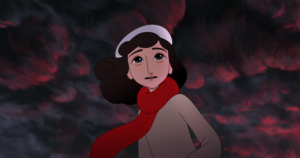At the 2022 San Diego Comic-Con, Marvel Studios announced – alongside the familiar onslaught of upcoming films and television shows – ‘The Multiverse Saga’, a title granted to the connective tissue of their future slate of big-budget superhero output.[1]See Richard Newby, ‘Where Marvel’s Multiverse Saga Could Go’, The Hollywood Reporter, 26 July 2022, <https://www.hollywoodreporter.com/movies/movie-features/where-marvels-multiverse-saga-could-go-1235186414/>, accessed 9 August 2022. That one of the world’s largest entertainment companies felt confident enough to slap ‘multiverse’ on such a titanic franchise suggests the ubiquity of the concept in contemporary (pop) culture.
It’s also not a huge surprise if you’ve been paying cursory attention to Marvel’s output over the past few years. Spider–Man: Far from Home (Jon Watts, 2019) alluded to the concept of other universes interacting with our own in its introduction of antagonist Mysterio (Jake Gyllenhaal), though it turned out to be a scam in the context of the film. The subsequent instalment, Spider-Man: No Way Home (Watts, 2021), put the multiverse front and centre, bringing in Spider-Man actors from prior films – sorry, other universes – to incredible box-office returns. The first season of Marvel’s Loki, premiering in June last year, explored the notion of manifold universes as well, before Doctor Strange in the Multiverse of Madness (Sam Raimi, 2022) made them so central to its narrative that the word ‘multiverse’ was shoved into its mouthful of a title.
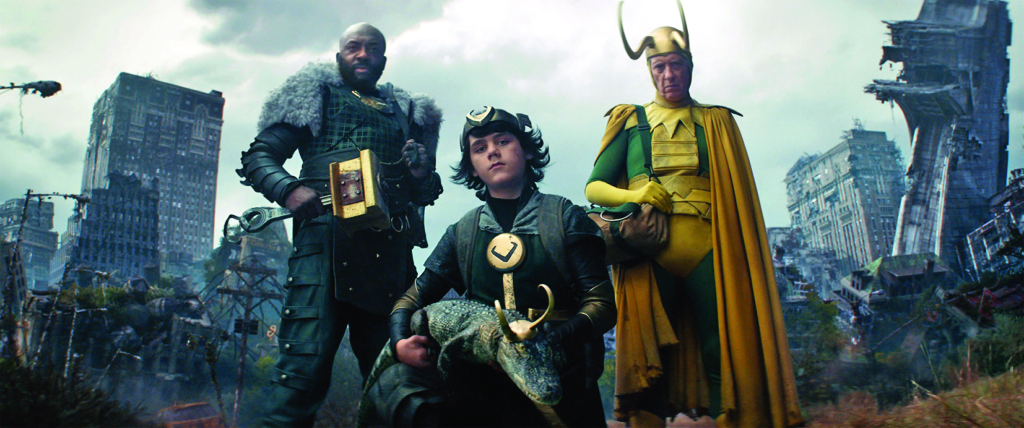
Lest we mistakenly assume that Marvel Studios has a monopoly on the concept, the idea of the multiverse – the collision of distinct universes – has been around in popular media for a while now. Sure, some of these are just other iterations of Marvel properties, whether it’s comic books or the animated feature Spider–Man: Into the Spider–Verse (Bob Persichetti, Peter Ramsey & Rodney Rothman, 2018). But there was a spike of interest in multiverses in the 1990s, as long as ‘slide’ was in the title somewhere: think Sliding Doors (Peter Howitt, 1998) and the sci-fi series Sliders. And of course we can’t neglect to mention Everything Everywhere All at Once (Daniel Kwan & Daniel Scheinert, 2022), the critically celebrated multiverse dramedy that’s become indie studio A24’s highest-grossing film.[2]See Mey Rude, ‘Everything Everywhere All at Once Is Now A24’s Highest Grossing Film’, Yahoo Entertainment, 11 June 2022, <https://www.yahoo.com/entertainment/everything-everywhere-once-now-a24s-184105419.html>, accessed 8 August 2022.
In short, the multiverse is – fittingly enough – everywhere. But where did it come from? And does it have any scientific basis?
Infinite universes, infinite storytelling potential
As you might expect from a column titled Cinema Science, there will be plenty of attention given here to the scientific underpinning of the multiverse. But before we start digging into the nuts and bolts of the topic, I think it’s worth clarifying the purpose the multiverse achieves in storytelling and why it’s seemingly spiked in popularity in recent years, as well as how it’s used differently to the ‘what if?’ mode of storytelling popularised by the likes of Sliding Doors and Sliders.
Moviemaking has become a business of extremes over the past couple of decades. Glance at the marquee of any multiplex and, increasingly, you’ll see movies with nine-figure budgets crowding out smaller films. There are countless analyses of this phenomenon – crediting the shift variously to the growing importance of the international market, the rise of streaming or the improvement of home-entertainment technology – but, for now, just take my word for it.
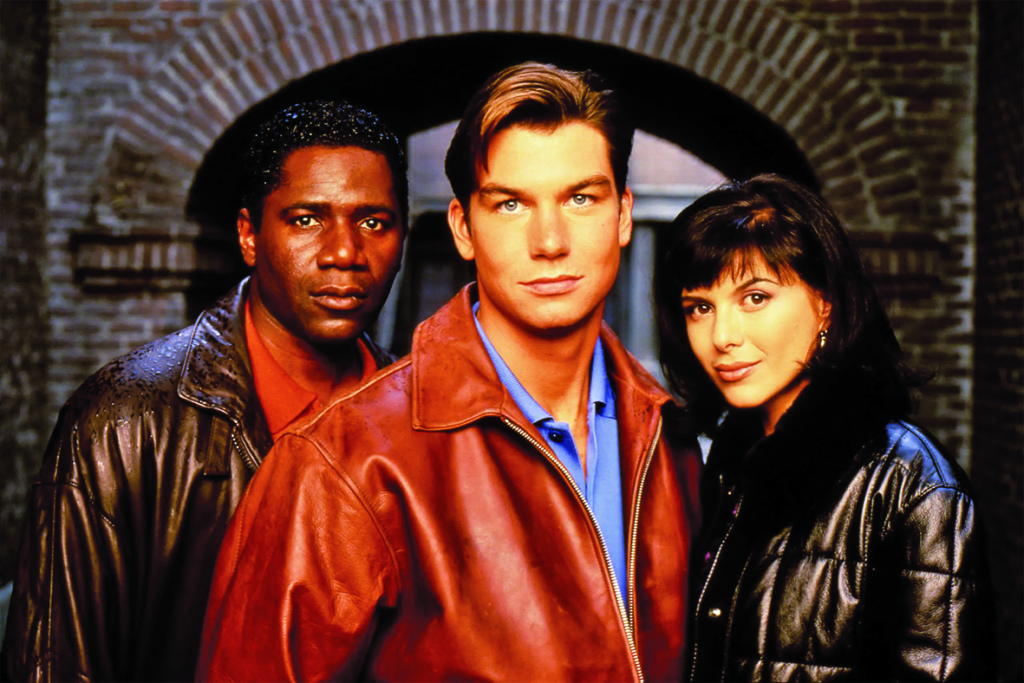
The end result here is that these big-budget films are inherently riskier for their production studios; pour a few hundred million bucks into a movie and a disappointing box office might result in bankruptcy. So, more and more, studios are looking for risk mitigation in the form of dependable intellectual properties. Established franchises aid in this – here’s another Star Wars, another Minions, another Fast & Furious – but they’re hardly bulletproof; Solo: A Star Wars Story (Ron Howard, 2018) underperformed substantially at the box office despite its pedigree.
The lesson (or, at least, the lesson Hollywood seems to have learned)? Audiences don’t just want Han Solo (Harrison Ford / Alden Ehrenreich) – they want the Han Solo they grew up with. So, even as Marvel Studios loses iconic actors like Robert Downey Jr and Chris Evans to lapsed contracts,[3]See Ian Sandwell, ‘Marvel’s Robert Downey Jr Reflects on Retiring from MCU with Chris Evans’, Digital Spy, 26 August 2019, <https://www.digitalspy.com/movies/a28820085/avengers-endgame-robert-downey-jr-chris-evans-mcu-exit/>, accessed 9 August 2022. they’re able to leverage the nostalgia of Tobey Maguire as Spider-Man or Patrick Stewart as Professor X through the conceit of the multiverse.

It’s a clever, if inelegant, solution, and one that’s largely paying off at the box office (at the time of writing, Spider-Man: No Way Home is the sixth-highest-grossing film of all time[4]‘Top Lifetime Grosses’, Box Office Mojo, updated 8 August 2022, <https://www.boxofficemojo.com/chart/top_lifetime_gross/>, accessed 9 August 2022.). It’s important to note that this isn’t the only option to get the same end result. Animated (or partly animated) films have similarly exploited nostalgia ever since Who Framed Roger Rabbit (Robert Zemeckis, 1988); in more recent years, The Lego Movie (Phil Lord & Christopher Miller, 2014), Space Jam: A New Legacy (Malcolm D Lee, 2021) and even Chip ’n Dale: Rescue Rangers (Akiva Schaffer, 2022) have gotten in on the act. This phenomenon’s been around for longer than the idea of the multiverse – remember Bud Abbott & Lou Costello Meet Frankenstein (Charles Barton, 1948)?
From the studios’ perspective, the strength of the multiverse conceit is that it balances the bloat of cinematic universes.
But from the studios’ perspective, the strength of the multiverse conceit is that it balances the bloat of cinematic universes. Questions of continuity can be set aside to allow an actor from The Office (US)to waltz in as a popular figure without anyone batting an eyelid.5 And if you’re DC Films and you’re concerned that Ben Affleck isn’t sufficiently popular as Batman, get Michael Keaton on the line and bring back your daddy’s Dark Knight.[5]The return of Michael Keaton as Batman was just a (reliable) rumour for a while, but he was confirmed for the role shortly before the film was shelved by HBO. See Jason Guerrasio, ‘Batgirl Directors Confirm That Michael Keaton Plays Batman in the Upcoming HBO Max Movie’, Insider, 2 June 2022, <https://www.insider.com/batgirl-michael-keaton-batman-directors-confirmation-interview-2022-6>; and Natasha Jokic, ‘Here’s What’s Happening with the Chaos Surrounding the Batgirl Movie Being Scrapped After $90 Million Was Allegedly Already Spent’, BuzzFeed, 4 August 2022, <https://www.buzzfeed.com/natashajokic1/heres-whats-happening-with-the-chaos-surrounding-the>, both accessed 9 August 2022. There’s no doubt that the multiverse, like any marketing gimmick, will wear out its welcome with audiences soon enough; but given Hollywood’s propensity for making hay while the sun shines, I think it’s safe to rely on its ubiquity in franchise filmmaking for a little longer at least.
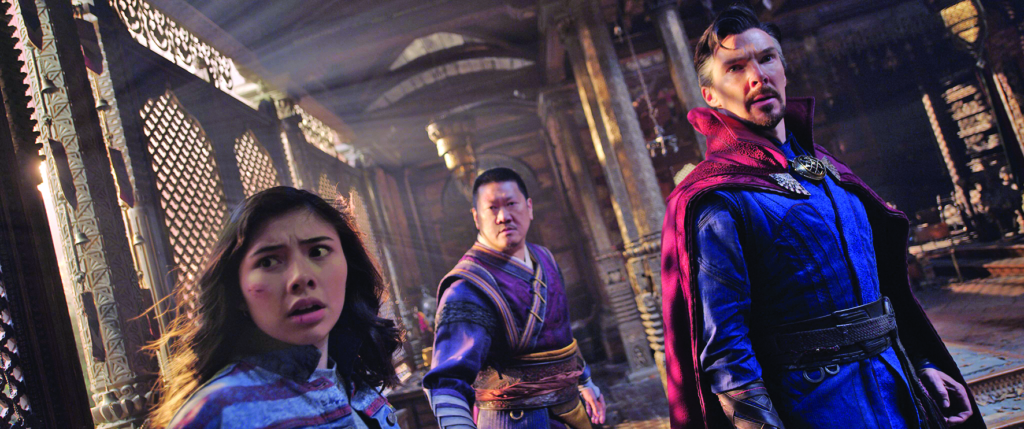
Many worlds, many hypotheses
I’m not quite entrenched enough in the Marvel Cinematic Universe to demarcate the ‘Multiverse Saga’ with complete confidence, but my understanding is that it will commence with Ant–Man and the Wasp: Quantumania in 2023. It’s a fitting film to start the saga with, given the Ant–Man films’ preoccupation with quantum physics and how that field ties into the scientific foundations of the multiverse.[6]For more on the science behind these films, see Dave Crewe, ‘Cinema Science: The Small Wonders of Ant–Man and the Wasp’, Screen Education, no. 92, 2018, pp. 22–9.
Before we dig into the science any deeper, a brief disclaimer: I’ll be going over the broad strokes of the science of the multiverse for the purpose of discussion in a secondary classroom. Given my own background in the area is entirely attributable to autodidacticism and this is a branch of science that is evolving daily, don’t expect any scientific precision here – just something a little closer to reality than the films being examined.
One of the many curious properties of quantum mechanics is the so-called observer effect. The traditional demonstration of this phenomenon is the double-slit experiment,[7]An arguably even more famous example of the observer effect is ‘Schrödinger’s cat’ – which, I should stress, is a thought experiment, not an actual experiment, and I think is directly attributable to some of the misunderstandings of the observer effect discussed in this article. See Gerardo Amador, ‘How Most People Got Schrödinger’s Cat Thought Experiment Wrong’, Today I Found Out, 31 October 2020, <https://www.todayifoundout.com/index.php/2020/10/how-most-people-got-schrodingers-cat-thought-experiment-wrong/>, accessed 9 August 2022. in which the pattern created by a light source being directed through a pair of slits produces two different results – two thick bars corresponding to particle-based motion, or an interference pattern linked to wave-based motion – entirely based on whether someone records which slit the photon (that is, a particle of light) travels through. This leads to a seemingly counterintuitive result: physics works differently depending on whether you’re watching.[8]For more on the double-slit experiment, See Anil Ananthaswamy, ‘What Does Quantum Theory Actually Tell Us About Reality?’, Scientific American, 3 October 2018, <https://blogs.scientificamerican.com/observations/what-does-quantum-theory-actually-tell-us-about-reality/>, accessed 9 August 2022.

Before we enter the multiverse, it’s necessary to clarify a common misconception relating to quantum mechanics. The results of the double-slit experiment are indeed affected by observation, but not – as popular culture might imply – because the photon’s behaviour has been meaningfully modified by its interaction with a sentient witness. We’re not special. What creates the difference in each version of the experiment is that, in order for scientists to record which slit each photon travels through, they have to do so through interacting with the photon – by, say, bouncing another photon off it. This ‘observation’ isn’t contingent on human interaction; but through this interaction (or observation), the photon’s probability wave collapses.
This notion of a probability wave is integral to much of multiverse science, certainly those that stem from the ‘many-worlds’ interpretation of quantum physics.[9]For more on the ‘many-worlds’ interpretation of quantum mechanics, see Adam Becker, ‘The Difficult Birth of the “Many Worlds” Interpretation of Quantum Mechanics’, Scientific American, 21 March 2018, <https://blogs.scientificamerican.com/observations/the-difficult-birth-of-the-many-worlds-interpretation-of-quantum-mechanics/>, accessed 9 August 2022. That photon, you see, doesn’t go through one slit or the other – it’s a cloud of probabilities that travels through both slits (at least, unless we force it to go through one by observing it). We should instead call this probability wave the photon’s wave function: we’re not describing where we expect the photon to be, but where it actually is. I’ll concede that this is confusing. But, for now, let’s accept the following: a quantum particle exists as a probabilistic cloud, a superposition in which it exists, to varying degrees, in multiple places at once. By ‘observing’ it, we collapse that cloud and lock it in to a particle position. Still with me?

This, proponents argue, is the root of the multiverse: when that cloud collapses (that is, when we move from an interference pattern to two dark bars in the twin-slit experiment), we’ve joined an entirely new universe. The ‘many-worlds’ interpretation specifically posits that this wave function can be considered as a set of universes – the multiverse, in short – with every possible quantum measurement its own universe: maybe in universe 616, that photon travels through the left slit; but in universe 838, it’s going right.[10]See John Gribbin, ‘The Many-worlds Theory, Explained’, The MIT Press Reader, 20 May 2020, <https://thereader.mitpress.mit.edu/the-many-worlds-theory/>, accessed 10 August 2022.
This is distinct from the conventional presentation of the multiverse in science fiction … but runs pretty well parallel to a specific fictional model of the multiverse. Everything Everywhere All at Once is a good example of this, as – to a lesser degree – is Sliding Doors. In this model, the multiverse ‘splits’ when meaningfully different decisions are made: Helen (Gwyneth Paltrow) dithering and missing that train; or Evelyn (Michelle Yeoh) choosing to leave home in her youth. That’s realised explicitly in Everything Everywhere All at Once, with a computer model of the multiverse portraying a web of different universes (including, memorably, one in which humans have hot dogs instead of fingers), their proximity contingent on the significance of the differences between them.

That’s not precisely how science views the multiverse – again, these narratives are privileging conscious decisions, whereas in reality, according to this model, there’d be countless universes distinguished solely by one photon bouncing slightly differently off a pane of glass. But at least we can see there’s a foundation to the Everything Everywhere All at Once multiverse; perhaps we can credit each different decision to a wave function deep within one person’s brain – one neuron firing differently! – and the significance of the end result is simply more apparent to audiences.
These narratives are privileging conscious decisions, whereas in reality, according to this model, there’d be countless universes distinguished solely by one photon bouncing slightly differently off a pane of glass.
More amusingly, though, even many of the truly silly multiverses posited by the aforementioned Marvel movies aren’t entirely out of the question here. Sure, maybe there is a universe with a crime-fighting spider-pig, or where the same person is twenty years older and … played by a different actor? Okay, perhaps that’s a stretch. But the mind-bogglingly immense nature of real multiverse theories allows for hot-dog fingers and spider-pigs alike if you can collapse enough wave functions in the right way. (I’m not sure that I can buy the brief flash of an entirely animated universe in Doctor Strange in the Multiverse of Madness, but I’ll leave that one to the experts).
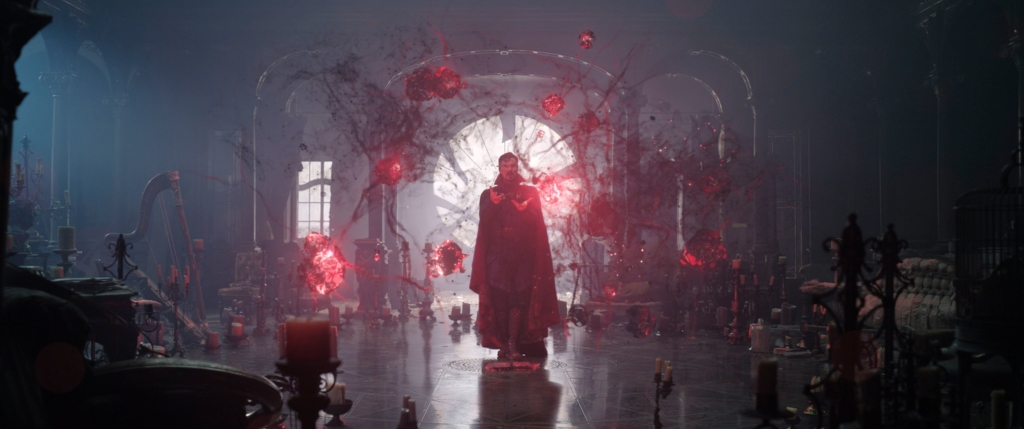
It’s also worth noting that the ‘many-worlds’ interpretation of quantum physics is just one iteration of the multiverse in modern science. There are other models for the multiverse that stem from an interrogation of the physics of our universe and its ever-intriguing quirks. There’s even a categorisation of different multiverse theories: Level 1 is essentially a set of universes following the same fundamental rules as our own; Level 2 includes universes with different fundamental constants; Level 3 is the ‘many-worlds’ interpretation; and Level 4 allows for any universe that you can find a valid mathematical model for.[11]See this charmingly retro website from cosmologist Max Tegmark: Tegmark, ‘Welcome to My Crazy Universe’, The Universes of Max Tegmark, <https://space.mit.edu/home/tegmark/crazy.html>, accessed 9 August 2022. (Interested readers might also want to explore physicist Brian Greene’s nine types of multiverses.[12]See Brian Greene, The Hidden Reality: Parallel Universes and the Deep Laws of the Cosmos, Penguin, London, 2011.)
At the end of the day, no screenwriter penning a new superhero film is going to be deeply invested in the scientific particulars of collapsing wave functions; they’re just looking to find an excuse for John Krasinski to make a cameo. But it speaks to the fascinating and mind-boggling nature of contemporary physics – and our own uncertainty about our very reality – that these flights of fantasy are founded on real science.
Endnotes
| 1 | See Richard Newby, ‘Where Marvel’s Multiverse Saga Could Go’, The Hollywood Reporter, 26 July 2022, <https://www.hollywoodreporter.com/movies/movie-features/where-marvels-multiverse-saga-could-go-1235186414/>, accessed 9 August 2022. |
|---|---|
| 2 | See Mey Rude, ‘Everything Everywhere All at Once Is Now A24’s Highest Grossing Film’, Yahoo Entertainment, 11 June 2022, <https://www.yahoo.com/entertainment/everything-everywhere-once-now-a24s-184105419.html>, accessed 8 August 2022. |
| 3 | See Ian Sandwell, ‘Marvel’s Robert Downey Jr Reflects on Retiring from MCU with Chris Evans’, Digital Spy, 26 August 2019, <https://www.digitalspy.com/movies/a28820085/avengers-endgame-robert-downey-jr-chris-evans-mcu-exit/>, accessed 9 August 2022. |
| 4 | ‘Top Lifetime Grosses’, Box Office Mojo, updated 8 August 2022, <https://www.boxofficemojo.com/chart/top_lifetime_gross/>, accessed 9 August 2022. |
| 5 | The return of Michael Keaton as Batman was just a (reliable) rumour for a while, but he was confirmed for the role shortly before the film was shelved by HBO. See Jason Guerrasio, ‘Batgirl Directors Confirm That Michael Keaton Plays Batman in the Upcoming HBO Max Movie’, Insider, 2 June 2022, <https://www.insider.com/batgirl-michael-keaton-batman-directors-confirmation-interview-2022-6>; and Natasha Jokic, ‘Here’s What’s Happening with the Chaos Surrounding the Batgirl Movie Being Scrapped After $90 Million Was Allegedly Already Spent’, BuzzFeed, 4 August 2022, <https://www.buzzfeed.com/natashajokic1/heres-whats-happening-with-the-chaos-surrounding-the>, both accessed 9 August 2022. |
| 6 | For more on the science behind these films, see Dave Crewe, ‘Cinema Science: The Small Wonders of Ant–Man and the Wasp’, Screen Education, no. 92, 2018, pp. 22–9. |
| 7 | An arguably even more famous example of the observer effect is ‘Schrödinger’s cat’ – which, I should stress, is a thought experiment, not an actual experiment, and I think is directly attributable to some of the misunderstandings of the observer effect discussed in this article. See Gerardo Amador, ‘How Most People Got Schrödinger’s Cat Thought Experiment Wrong’, Today I Found Out, 31 October 2020, <https://www.todayifoundout.com/index.php/2020/10/how-most-people-got-schrodingers-cat-thought-experiment-wrong/>, accessed 9 August 2022. |
| 8 | For more on the double-slit experiment, See Anil Ananthaswamy, ‘What Does Quantum Theory Actually Tell Us About Reality?’, Scientific American, 3 October 2018, <https://blogs.scientificamerican.com/observations/what-does-quantum-theory-actually-tell-us-about-reality/>, accessed 9 August 2022. |
| 9 | For more on the ‘many-worlds’ interpretation of quantum mechanics, see Adam Becker, ‘The Difficult Birth of the “Many Worlds” Interpretation of Quantum Mechanics’, Scientific American, 21 March 2018, <https://blogs.scientificamerican.com/observations/the-difficult-birth-of-the-many-worlds-interpretation-of-quantum-mechanics/>, accessed 9 August 2022. |
| 10 | See John Gribbin, ‘The Many-worlds Theory, Explained’, The MIT Press Reader, 20 May 2020, <https://thereader.mitpress.mit.edu/the-many-worlds-theory/>, accessed 10 August 2022. |
| 11 | See this charmingly retro website from cosmologist Max Tegmark: Tegmark, ‘Welcome to My Crazy Universe’, The Universes of Max Tegmark, <https://space.mit.edu/home/tegmark/crazy.html>, accessed 9 August 2022. |
| 12 | See Brian Greene, The Hidden Reality: Parallel Universes and the Deep Laws of the Cosmos, Penguin, London, 2011. |




